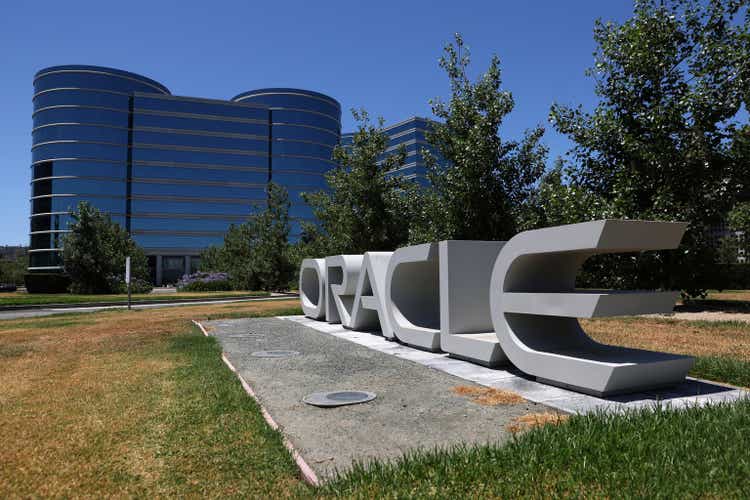Justin Sullivan
It has been a very long time since I last covered Oracle Corporation (NYSE:ORCL). In fact, it was spring of 2018 when I concluded that Oracle should “stop the talk, do the walk.” At the time, headline revenue growth was the problem, while executives were touting growth and initiatives, yet cold hard growth numbers (or lack thereof) did not rhyme with the talk.
Despite an attractive valuation, I wished that management would become a bit more realistic at the time.
The Base Case
Nearly five years ago, Oracle was a $44 stock which posted revenues at a run rate of around $40 billion. While the company posted 6-7% topline sales growth, this was largely driven by a weaker dollar, as growth came in at just 2% or so in constant currency terms, with cloud revenue growth slowing down in a rather rapid fashion. That was important, as the company was in its early innings of a transition to SaaS, PaaS and IaaS revenues, combined making up just around 15% of total sales.
With adjusted earnings trending around $3 per share, I pegged realistic earnings around $2.70 per share after backing out stock-based compensation expenses. A net cash position of $10 billion was equal to just over $2 per share, based on a 4.2 billion share count. This means that operating assets were valued at $42 per share and about 15-16 times realistic earnings. With the company holding large absolute cash and debt holdings, related to foreign taxes, the company incurred quite some negative interest spread. Once eliminated, it could boost earnings quite a bit, as this was a potential trigger to create value.
Nonetheless, the real appeal had to come from a stronger growth trajectory, as the sum of the part analysis and a strong balance sheet all were reasons for me to be upbeat at the time.
Coming Alive – Then Not So Much
After trading in the mid-forties in 2018, shares long traded around the $50 mark until the outbreak of the pandemic. Late in 2020, the company announced a massive $28 billion deal to acquire Cerner, the provider of digital information systems in hospitals and health systems, in order to gain a greater foothold in this business. Following a long review period, the deal only closed in June of this year.
Amidst general market enthusiasm and investors apparently liking this deal, shares rallied during 2021 and hit a high of $106 late in 2021, following which shares have seen a huge sell-off to $61 per share now. This move lower has wiped out most, but not all, gains since the outbreak of the pandemic.
On the fundamental front, the company posted its 2022 results in June of this year. Revenues were up 5% to $42.4 billion, which just shows that revenues have not really moved up that much since 2018. Non-GAAP earnings were reported at $13.7 billion, which means that adjusted earnings rose to $4.90 per share, as adjusted earnings per share have moved up more than 50% in 2018. This is the result of the continued cloud transition, which is not showing up in real revenue growth. Higher earnings per share are not the result of higher margins, but are the result of massive buybacks, as the share count of 2.7 billion shares has been cut by a third from 2018.
This comes at a huge expense, notably a $54 billion net debt load on the back of huge buybacks, as this was even ahead of the Cerner deal. With adjusted operating earnings pegged at $17 billion (if I exclude stock-based compensation expenses), leverage was manageable but quite significant (certainly in relation to the past practice of Oracle on this front).
In September, Oracle posted its first quarterly earnings reported following the Cerner deal. Reported revenues rose 18%, albeit a strong dollar hurt sales growth by five points. Adjusted operating earnings inched up modestly to $4.5 billion, yet adjusted earnings of $1.03 per share were flat, the result of a slightly higher tax rate. With the Cerner deal having closed, net debt has inched up to $80 billion as these interest expenses start to get very substantial.
And Now?
Even with earnings power trending probably around $4.50 per share in a realistic scenario, I am not automatically appealed to a 13-14 times earnings multiple. Right now, the company is awarded a $160 billion equity valuation, which is actually down from about a $185 billion valuation early in 2018 at $45 per share, the result of huge buybacks.
The issue is that a $10 billion net cash position has turned into an $80 billion net debt load, as the enterprise valuation has moved up from $175 billion to $240 billion over the same period of time. This move includes the purchase of Cerner, as it shows that amidst flattish revenue trends (excluding Cerner) the issue is that progress has not been that pronounced, as has been the case for years now.
While current multiples have come down a lot, I note that valuations of Oracle have historically been non-demanding, as the company has been moving from a net cash position into a very substantial net debt load. This leverage means that the optical low earnings multiple does not look as cheap as was the case in recent years, making me very cautious here, as more quality names are sold off here as well.


Be the first to comment